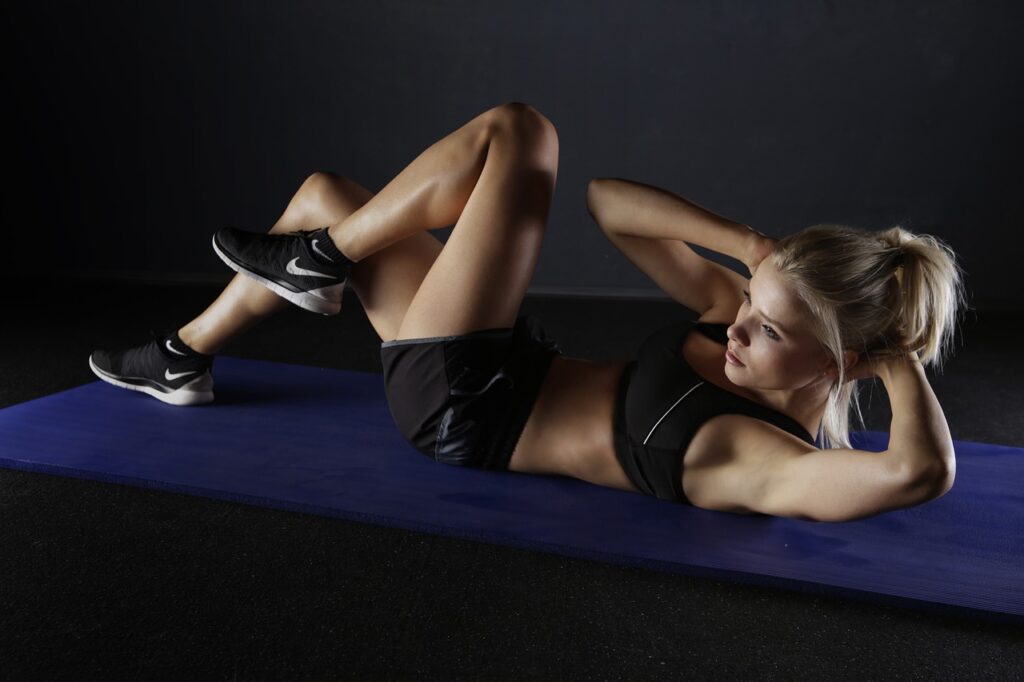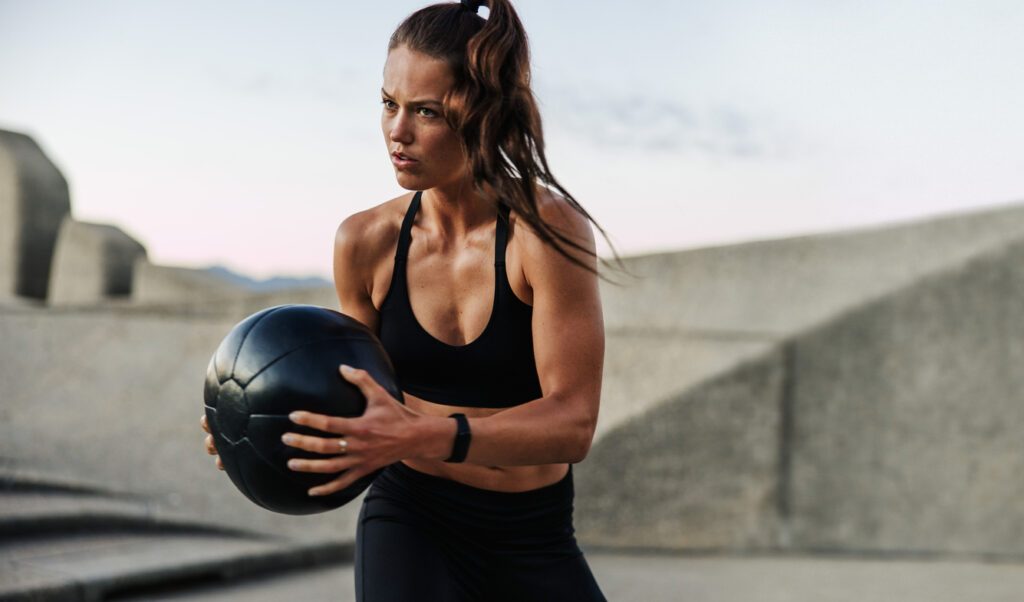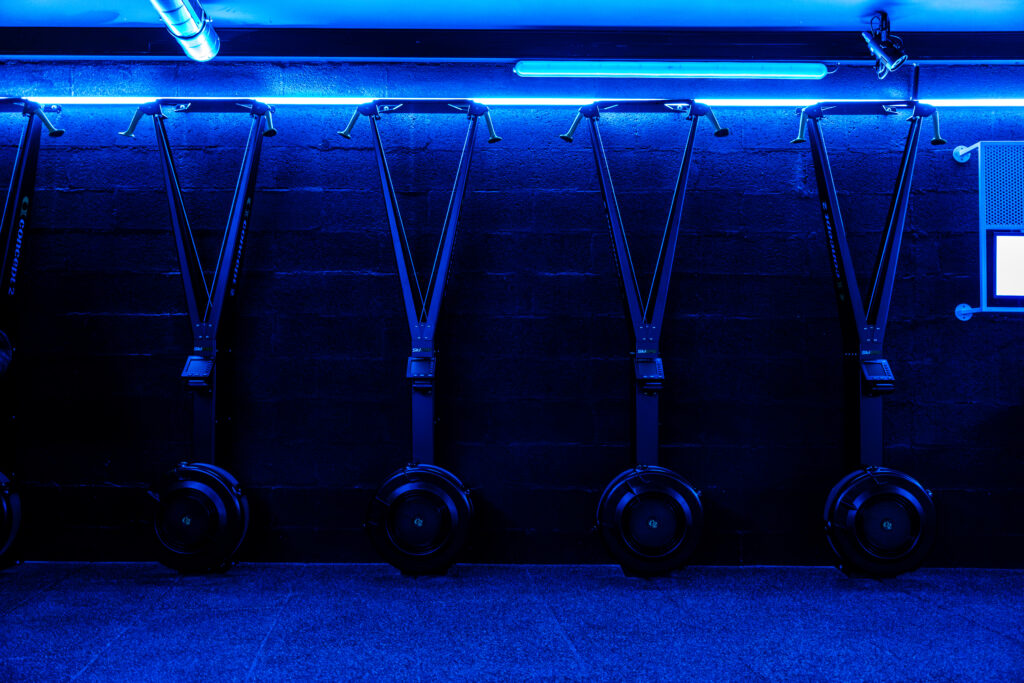
Summary
Welcome / Welcome / Tips for getting started / Home crossfit exercise: our selection of effective exercises
Home crossfit exercise: our selection of effective exercises
Improve your physical condition with the CrossFit at homeThis flexible method is perfect for those who don't have access to a gym or specific equipment. The Bodyweight CrossFitor bodyweight trainingIt allows you to follow an intense and varied training routine, no matter where you are or how much time you have.
Practising CrossFit at home, without any equipment, offers a great flexibility and allows you to train anywhere - on the move, at home, or even outside. It maintains the essence of CrossFit: variety of exercisesThis article guides you through the best CrossFit exercises and programmes to do at home to boost your fitness without equipment. This article guides you through the best CrossFit exercises and programmes to do at home to boost your fitness without equipment.
Introduction to CrossFit at home
THE CrossFit at home stands out for its flexibility and its accessibilityThis method, often referred to as 'bodyweight training', is based on using your own bodyweight as resistance, eliminating the need for special equipment. This method, often referred to as 'bodyweight CrossFit' or 'bodyweight training', relies on using your own bodyweight as resistance, eliminating the need for special equipment.
Practising CrossFit at home maintains the fundamental principles of CrossFit, such as the variety of exercises, THE functional movementsand intense workouts. Basic exercises such as burpees, push-ups, squats, sit-ups, and lunges are essential elements that can be adapted in many ways to create WODs (Workout of the Day) stimulating and varied.
One of the main advantages of CrossFit at home is its ability to adapt to all fitness levels. Whether you're a beginner or an experienced athlete, you can tailor the intensity and complexity of the exercises to suit your personal needs and goals. Beginners can opt for simplified versions of the moves, while the more advanced can challenge themselves with more complex variations, such as handstand push-ups or pistol squats.
What's more, CrossFit at home encourages a deeper connection with your bodyThis will improve your understanding of your limits and capabilities. This develops discipline and consistency in your training, which are essential if you are to maintain optimal physical condition on an ongoing basis.
By combining high-intensity cardiovascular exercises, such as burpees or jumping jacks, with strengthening exercises, you can ensure an overall improvement in your fitness and cardiovascular health.
Finally, training in CrossFit at home offers a freedom of planning and extremely motivating organisation. You can create a structured plan, including precise objectives, adapted exercises and well-defined rest periods, all without being dependent on a specific location or particular equipment. This encourages regular practice, to maintain good habits and stay motivated, even when travelling or when access to a gym is limited.
Preparation and safety
Essential warm-up
Warming up plays a fundamental role before starting a CrossFit session, particularly when it takes place at home. It prepares your body for the intensity of the effort ahead, considerably reducing the risk of injury while boosting your performance.
Start with a light cardiovascular workout, such as running on the spot, doing handstands, and so on. jumping jacksor jumping rope. This will gradually raise your body temperature and heart rate. Continue with dynamic mobility exercises that target the main joints, paying special attention to the areas that are most in demand during your workout. WOD (Workout of the Day).
Also incorporate low-intensity movements specific to CrossFit, such as air squats, of the push-ups modified, or burpees slow, to prepare your muscles for the more intense exercises. Don't forget to add some core activation exercises to work the stabilising muscles, which are essential in almost all CrossFit movements. Conclude with a few low-intensity explosive moves to stimulate the nervous system and improve coordination.
Precautions to be taken
Before embarking on CrossFit training at home, it's essential to take certain precautions to ensure your safety and that of your environment. It's essential to set aside a specific area for your training sessions.
Make sure the space is large enough for wide movements such as burpees or squats, and safe enough to prevent accidents. Remove any potential obstacles such as mats, toys or cables. Make sure the room is well ventilated to keep you comfortable, especially during intense exercise, by opening windows or using a fan.
It is also essential that the area is well lit so that you can see your movements clearly and avoid any incidents. Keep a towel and bottle of water handy to keep hydrated and manage perspiration. Finally, make sure you have appropriate support, such as a sturdy chair for dips or step-ups, and use everyday objects safely to intensify your training without risk of injury.
Basic CrossFit exercises without equipment
Movements for the upper body
Exercises targeting the upper body are essential in CrossFit without equipment. They help to strengthen muscles chest, shoulders, triceps and back. Here are some of the most effective exercises:
Push-Ups A CrossFit classic, push-ups mainly target the pectorals, triceps and deltoids. They come in several variations, including standard, diamond and one-handed versions.
Dips without equipment Dips: Easy to do on a chair or windowsill, dips are perfect for strengthening the triceps and pectoral muscles. They can also be used as part of a warm-up to improve muscle preparation.
Handstand Push-Ups For the more advanced, these exercises effectively target the shoulders and chest. They require a good command of technique and a degree of flexibility, providing an intense upper-body workout.
Lower body exercises
Working the muscles of the thighs and buttocks is essential in CrossFit without equipment. Discover some fundamental exercises :
Squats Squats: Squats, including air squats and jump squats, are essential for strengthening the quadriceps, hamstrings and glutes. They lend themselves well to variations to adjust intensity.
Lunges Lunges: Lunges, including alternating versions and walking lunges, specifically target the thigh and buttock muscles. They help to improve balance and leg strength.
Pistol Squats Demanding, these single-leg squats intensively strengthen the thigh and buttock muscles. They require excellent control of balance and strength.
Complete movements
These exercises work on several muscle groups at once, providing a complete and intense workout:
Burpees Burpees are a versatile exercise that combines squats, push-ups and jumping. They work both the upper and lower body muscles, as well as the cardiovascular system.
Jumping Squats and Squat Jumps These exercises combine the explosive power of the legs with a cardiovascular effort, strengthening the thigh muscles and improving endurance.
EMOM (Every Minute On the Minute) and AMRAP (As Many Rounds As Possible) These training methods combine various exercises, such as burpees, push-ups and sit-ups, to create varied and stimulating sessions.
WODs (Workouts of the Day) to do at home
WODs for beginners
For beginners, it's essential to choose WODs that are both affordable and offer a progressive challenge. Here's a selection of WODs perfectly suited to novices:
Simple Burpees Burpee WOD: Doing as many burpees as you can in 8 minutes is a great way to familiarise yourself with this essential CrossFit movement. This WOD improves overall fitness and strengthens the upper and lower body muscles.
Bodyweight WOD Perform 3 sets of the following exercises: 10 air squats, 10 sit-ups, 10 push-ups and 10 burpees. This WOD is an ideal introduction to the fundamental exercises of CrossFit and requires no equipment.
Mini "Murph A lighter version of the famous "Murph" WOD, this mini "Murph" includes 400m of fast running, 40 air squats, 30 sit-ups, 20 rotations (or alternatives), 10 pull-ups (or alternatives), and finishes with 400m of fast running. It's designed to boost endurance and overall strength without the use of special equipment.
Intermediate WODs
Once you have mastered the basic movements, you can progress to intermediate WODs that increase in intensity and complexity:
"Cindy A classic WOD that involves doing as many rounds as possible in 20 minutes, with the following exercises: 5 pull-ups (or alternates), 10 push-ups, and 15 air squats. It's a great workout for building endurance and muscular power.
Cardio WOD without equipment A 15-minute AMRAP (As Many Rounds As Possible) consisting of 400m of running, 20 air squats, 20 push-ups and 20 sit-ups. This WOD is perfect for testing your cardiovascular and muscular endurance.
Full-Body Sprint A WOD where you have to complete a series of exercises in the shortest possible time. For example, run 400m, do 50 air squats, run 400m, do 50 push-ups, run 400m, do 50 sit-ups, and finish with a 400m run. That's a complete and intensive workout.
Advanced WODs
For more experienced athletes, here are some WODs that require superior strength, endurance and technique:
"MARY A WOD that aims to complete as many rounds as possible in 20 minutes, with the following exercises: 5 handstand push-ups, 10 single-leg squats, and 15 pull-ups. It's a challenge that focuses on gymnastic skills.
Full-Body Decreasing Ladder This WOD involves doing decreasing sets of burpees, push-ups, and sit-ups. For example, start with 10 rounds in the shortest possible time, doing 10 burpees, 10 push-ups, and 10 sit-ups, then decrease to 9, and so on down to 1.
Gymnastic Mastery A 20-minute AMRAP including 5 handstand push-ups and 10 single-leg squats. This WOD is excellent for advanced athletes wanting to perfect their gymnastic technique.
Weekly training programmes
4-week starter programme
For beginners, starting with a structured programme is essential to ensure that progress is both gradual and safe. Here's a 4-week programme designed specifically for those doing CrossFit at home:
Week 1 :
- Day 1: 10 push-ups, 10 sit-ups, 10 air squats (5 sets).
- Day 2: 1 km jog and 25 air squats (3 sets).
- Day 3: 20 lunges and 10 push-ups (5 sets).
- Day 4: jogging over 1 km (or another activity such as cycling or swimming) plus 1 minute of front plank and 1 minute of side plank on each side.
- Day 5: Rest.
- Day 6: 50-100 jumping jacks, 25 air squats, and 20 push-ups, for time.
- Day 7: 1.5 km jog for time.
Week 2 :
- Day 8: 1 air squat followed by a break, then 2 air squats and 2 breaks, up to 10, then back down to 1.
- Day 9: 1.5 km jog (or jump rope or short sprints) followed by 10 push-ups per minute.
- Day 10: 20 jumping jacks and 10 sit-ups (5 sets).
- Day 11: jogging over 1.5 km (or another activity such as cycling or swimming) with an extra 1 minute of front plank and 1 minute of side plank on each side.
- Day 12: Rest.
- Day 13: 10 push-ups, 10 sit-ups and 10 air squats (5 sets).
- Day 14: 50-100 jumping jacks, 25 air squats, and 20 push-ups (2 sets), for time.
This programme gradually increases in intensity and complexity, encouraging continuous improvement.
8-week intermediate programme
Intermediates need a more structured and intensive programme. Here's an example of an 8-week programme, inspired by CrossFit Open preparations:
Weeks 1-2 :
- 5 weekly sessions of 45-60 minutes, focusing on improving strength, endurance and technique. Sample session: 3 rounds of 10 air squats, 10 push-ups and 10 sit-ups, with 30 seconds' rest between each round.
Weeks 3-4 :
- Intensification with more demanding WODs, such as 15-minute AMRAPs including 400m of running, 20 air squats, 20 push-ups, and 20 sit-ups.
Weeks 5-6 :
- Introduction of more complex exercises such as handstand push-ups, pistol squats and pull-ups. Sample session: 3 rounds of 5 handstand push-ups, 10 pistol squats and 15 pull-ups, with at least 2 minutes' rest between each round.
Weeks 7-8 :
- Simulation of Open conditions with WODs combining several movements and optimal time management. Sample session: WOD simulating Open conditions, including pull-ups, push-ups, squats and runs, with a focus on time management and active recovery.
This programme aims to significantly improve physical fitness and overall performance, preparing athletes to take on more demanding challenges.
Nutrition and recovery
Diet for CrossFit
Diet is a fundamental pillar of CrossFit training, helping to optimise performance, facilitate recovery and encourage muscle growth. Discover the essential principles for a diet suited to CrossFit:
Macronutrient balance For a balanced diet, it is essential to ensure an adequate distribution of proteins, carbohydrates and fats. A common ratio is 30% protein, 55% carbohydrate and 15% fat.
Food quality Choosing high-quality foods is essential. Vary your sources of protein by including lean meat, omega-3-rich fish and eggs, and opt for complex carbohydrates from wholegrain cereals and pulses. Vegetables and fruit, rich in vitamins, minerals and antioxidants, are also essential.
Meal frequency Eating regularly: It's advisable to eat regularly, spreading your food intake over the day, to ensure you get enough calories and a constant supply of nutrients to your muscles. Try to eat around 5 meals a day, including snacks rich in protein and carbohydrates.
Hydration Stay well hydrated to support your performance and recovery. Drink between 2 and 2.5 litres of water a day to maintain optimum hydration.
Home recovery techniques
Muscle recovery is important in CrossFit. Several techniques can be applied at home to speed up this process:
Dynamic stretches Dynamic stretching before and after training increases muscle temperature, promotes blood circulation and improves joint flexibility. Incorporate stretches adapted to each muscle group into your warm-up and cool-down routines.
Sports massage Sports massage: Carried out by yourself or by a partner using massage tools, sports massage relaxes muscles, eases aches and stimulates blood circulation.
Compression and cryotherapy Use of compression bands and ice baths can speed up muscle recovery, reduce inflammation and improve circulation.
Relaxation techniques For a full recovery, mental and physical relaxation are essential. Meditation, deep breathing and yoga are excellent techniques for reducing stress and promoting muscle relaxation.
Post-training hygiene Don't neglect the importance of stretching, cooling down and showering after training. These gestures help to relax muscles, eliminate toxins and increase general well-being.
Progress monitoring and motivation
Progress monitoring and motivation are essential to maintaining a CrossFit training routine. effective and sustainable. Here are a few strategies to help you keep track of your progress and stay motivated:
Defining and monitoring specific objectives
It's essential to set clear, measurable goals to monitor your progress and keep you motivated. These goals can be general, such as "getting stronger" or "improving endurance", but they must also be specific and achievable. For example, aim to do 10 unassisted pull-ups, learn double-unders, or improve your time on a WOD like "Fran".
By breaking these goals down into smaller steps and celebrating each small victory, you can maintain constant motivation. Writing down your goals and posting them somewhere visible, such as on a post-it note on your mirror or on a whiteboard in your workspace, can also help you stay focused on your ambitions.
Using monitoring tools
Using tracking tools can make it much easier to monitor your progress. Applications such as Beyond The Whiteboard allow you to log your workouts, compare your performances and analyse performance metrics. These tools can also help you track your body composition and compare your results over specific WODs.
In addition, repeating benchmark WODs at regular intervals is a great way to measure your progress. WODs like 'Fran', 'Grace' and 'Cindy' are designed to test strength, speed and endurance, and repeating them every six months can provide a clear picture of your progress.
Maintaining variety in training
Maintaining variety in your workouts is essential to avoid monotony and plateauing. Incorporating different types of exercise, such as weightlifting, calisthenics and cardio, can keep your workouts stimulating.
Taking part in classes or training in different gyms or studios, or trying outdoor training, can also add variety to your routine.
Find a training partner and a support community
Having a training partner or being part of a support community can considerably improve your motivation and commitment. Having someone who counts on your presence at training can be a great motivator.
A CrossFit community can offer encouragement, support and healthy competition, helping you to stay consistent and motivated.
Remembering your "why
When it's hard to stay motivated, remembering why you started CrossFit can be invaluable. Thinking about the benefits it has brought into your life, such as an improved health, a increased confidenceor a sense of belonging to a communitycan play a key role in maintaining your determination.
Even if your initial motivations have changed, recognising thepositive impact that CrossFit has on your life can give you the energy you need to persevere.
It's important to understand that motivation shouldn't be the only driving force behind your workouts. By turning exercise into a daily habit, you ensure continued adherence to your training routine, even when your motivation wanes. Armed with patience and these methods, you'll be able to achieve your nutrition and fitness goals in a lasting and rewarding way.
Conclusion
In conclusion, CrossFit at homeeven without any equipment, is proving to be a very effective method. accessible and efficient to boost your fitness. It's essential to start with the basics, i.e. squats, push-ups, sit-ups and burpees.
A good warm-up, balanced nutrition and recovery strategies are essential to prevent injury and keep you motivated.
By adopting a well-structured training plan, diversifying your sessions to break the monotony, and choosing WODs that correspond to your level, you'll see noticeable improvements. It's important to adjust your exercises according to your abilities, allowing time for rest and respecting your personal rhythm.
It's time to take action! Choose a suitable space, set yourself some clear goals, and embark on your CrossFit adventure.
With perseverance and a progressive approach, you can transform your physical condition and significantly improve your quality of life.
FAQs
How can I do cross training at home?
To practise cross-training at home, you don't need any special equipment. Here are a few key exercises and routines to incorporate:
- Burpees A dynamic sequence of squats, push-ups and jumps.
- Push-ups Adapt the difficulty to your fitness level.
- Squats Use your body weight or add weight with a rucksack filled with books or water bottles.
- Lunges Alternate front and back lunges for each leg.
- Mountain climbers In plank position, bring your legs towards your chest, alternating quickly.
- Plank Hold the plank position, gradually increasing the duration.
- Rope jumps : Practise jumping rope, or simulate jumping if you don't have one.
Create high-intensity circuits by combining these exercises, with short rest periods in between, for a complete workout.
Is it a good idea to do CrossFit every day?
It's not advisable to practise CrossFit every day. Even for experienced athletes, it's best to limit sessions to 3 to 5 times a week. Too much frequency can lead to overtraining, fatigue and slow your progress. Rest days are essential for the body's recovery and to reduce the risk of injury.
What are CrossFit exercises?
CrossFit offers a wide variety of exercises targeting endurance, strength and flexibility. Fundamental exercises include :
- Squats Air Squat, Front Squat, Overhead Squat, Back Squat.
- Presses Shoulder Press, Push Press, Push Jerk.
- Deadlifts Deadlift, Sumo Deadlift High Pull.
- Bodyweight exercises Pull-Ups, Push-Ups, Burpees, Handstand Push-Ups, Pistols (single-leg squats), Toes to Bar, Handstand Hold, Muscle Ups.
- Olympic weightlifting Snatch, Clean and Jerk, Clean and Press.
- Others Box Jumps, Dumbbell Thrusters, Kettlebell Swings, Rope Climbs, L-sits, as well as various forms of lunges and rows.
How do I set up a CrossFit programme?
To set up a CrossFit programme, start with a thorough introduction for beginners, with 4 to 5 sessions to master the basic movements and safety instructions. Introduce the philosophy of CrossFit, its benefits and its community spirit.
Focus on fundamental movements such as squats, push-ups and deadlifts, with an emphasis on form and safety. For regular sessions, organise varied Workouts of the Day (WODs), mixing functional movements, weight lifting, core exercises and cardio activities. Vary the duration and types of exercise to avoid routine and ensure smooth progression.
Share
Tagged
Read also
follow us
on instagram
To follow all our news,
take advantage of our tutorials and participate
in our many competitions.
BREAKING NEWS!
Receive our newsletter.





